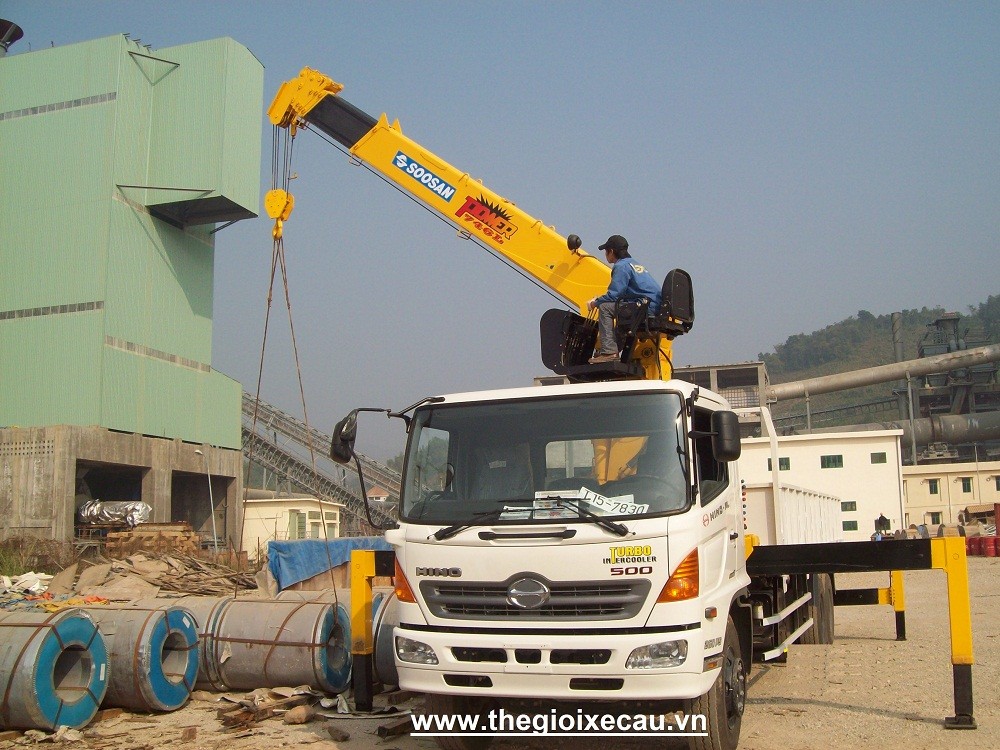Truck-mounted cranes, also known as crane trucks or lorry loaders, are increasingly popular in Vietnam due to their ability to transport goods combined with flexible loading and unloading. As truck experts at Xe Tải Mỹ Đình, we recognize the growing demand for information about types of truck-mounted cranes. This article provides more detailed and comprehensive information than the original, helping customers understand the different crane types, their applications, advantages, disadvantages, and how to choose the most suitable crane for their needs in the Vietnamese market.
What is a Truck-Mounted Crane?
A truck-mounted crane is a perfect combination of a cargo truck and a hydraulic crane. This is a versatile specialized vehicle that integrates the cargo transportation capabilities of a regular truck with the lifting and loading/unloading capabilities of a crane. The main components of the vehicle are:
- Base Truck: Typically common commercial truck models available in the Vietnamese market, ensuring flexible mobility on roads. Popular truck brands used as base trucks include Hino, Isuzu, Hyundai, Dongfeng, Thaco, and many others. Base trucks are classified by tonnage (light, medium, heavy), number of axles (2-axle, 3-axle, 4-axle), cargo payload, and gross vehicle weight rating.
- Hydraulic Crane: The crucial component that gives truck-mounted cranes their special functionality. The hydraulic crane uses a powerful hydraulic pump system combined with mechanical linkages to perform lifting, lowering, boom extension/retraction, and 360-degree rotation operations, making cargo handling easy and efficient. The crane is equipped with hydraulic outriggers to ensure vehicle stability and safety when lifting loads.
Detailed Structure of a Truck-Mounted Crane
Base Truck
The base truck for truck-mounted cranes is diverse, depending on the required payload and cargo dimensions. Factors to consider when choosing a base truck include:
- Payload: Choose a truck with a payload capacity suitable for the weight of goods frequently transported and the crane’s lifting capacity.
- Cargo Box Size: The size of the cargo box must meet the cargo space requirements and be suitable for the wheelbase to accommodate the crane installation.
- Operating Performance: A powerful engine, stable transmission system, and flexible mobility on various terrains are important factors.
- Brand and Durability: Prioritize reputable truck brands with proven quality and durability in the market.
Hydraulic Crane
The hydraulic crane is the heart of the truck-mounted crane, determining its lifting and loading/unloading capabilities. There are two common types of hydraulic cranes:
- Telescopic Crane: This type of crane has a telescopic boom that can be extended and retracted flexibly. Telescopic cranes are favored for their long reach, ability to lift loads at height and distance, suitable for erection work, lifting building materials, and bulky goods. Well-known telescopic crane brands include Unic, Tadano, Soosan, and Kanglim.
- Knuckle Boom Crane: This type of crane has a boom divided into multiple sections connected by hinged joints, allowing the crane to fold compactly like a robot arm. Knuckle boom cranes are advantageous for working in confined spaces, high precision, fast and powerful operation at close range. Leading knuckle boom crane brands include Hyva, Palfinger, Fassi, and Hiab.
Connection between hydraulic crane and base truck: The crane is firmly mounted onto the base truck through a crane mounting system and base, ensuring stability and safety during operation. The chassis is often reinforced to withstand the forces from the crane and cargo.
**
Crane mounting system connecting crane to truck chassis
Crane anti-collision block: A small but important detail, ensuring the crane does not shift when the vehicle brakes suddenly or accelerates abruptly.
Crane hook pulley assembly: Equipped on telescopic cranes, helping to increase lifting capacity and adjust the lifting angle of the load.
Control System: Cranes are controlled by hydraulic control levers, usually located next to the crane base. Larger cranes are often equipped with an elevated operator seat or remote control for increased visibility and convenience.
Crane control levers:
Crane hydraulic control levers
Power Take-Off (PTO): Transmits power from the base truck engine to the hydraulic pump of the crane, enabling crane operation.
Diverse Applications of Truck-Mounted Cranes
Truck-mounted cranes offer comprehensive transportation and cargo handling solutions, widely used in many fields:
- Construction: Transporting and lifting building materials (steel, cement, bricks, tiles), erecting structures, supporting construction projects.
- Transportation: Loading and unloading goods at warehouses, seaports, railway stations, transporting oversized and overweight cargo.
- Industry: Lifting machinery, equipment, materials, supporting installation and maintenance of production lines.
- Urban Environment: Planting urban greenery, installing and maintaining lighting systems, billboards.
- Rescue Operations: Responding to incidents and disasters, moving and lifting heavy objects in rescue work.
Truck crane assisting in the steel, construction materials, and manufacturing industries
**
Truck crane working at a steel factory
Truck-mounted crane for construction and urban greening projects
**
Truck-mounted crane lifting a tree in an urban environment
Classification of Truck-Mounted Cranes
Classifying types of truck-mounted cranes helps customers easily choose the product that best suits their needs and purposes. Here are common classifications:
1. Classification by Crane Lifting Capacity and Truck Payload
- By crane lifting capacity:
- Small capacity cranes: Lifting capacity from 1 to 5 tons, suitable for small trucks and light, retail cargo handling.
- Medium capacity cranes: Lifting capacity from 5 to 10 tons, common on medium and heavy-duty trucks, meeting diverse needs in construction and transportation.
- Large capacity cranes: Lifting capacity over 10 tons, used on heavy-duty trucks and tractor-trailers, serving large projects and handling super-heavy and oversized cargo.
- By truck payload capacity:
- Light payload truck-mounted cranes: Payload capacity from 1 to 5 tons, usually using 4×2 trucks.
- Medium payload truck-mounted cranes: Payload capacity from 5 to 10 tons, using 4×2 or 6×4 trucks.
- Heavy payload truck-mounted cranes: Payload capacity over 10 tons, using 6×4, 8×4, or 10×4 trucks.
Choosing the crane lifting capacity and truck payload needs to ensure balance and harmony, avoiding situations where the crane is too weak for the truck or vice versa. It is advisable to consult with reputable suppliers for optimal choices. Popular crane lifting capacities favored in Vietnam are: 2 tons, 3 tons, 5 tons, 7 tons, 10 tons, 12 tons, and 15 tons.
2. Classification by Hydraulic Crane Structure
As mentioned above, there are two main types of hydraulic crane structures mounted on trucks:
- Truck-mounted telescopic crane:
- Advantages: Long reach, good lifting ability at height and distance, initial investment cost is often lower than knuckle boom cranes, suitable for many base truck types.
- Disadvantages: Limited working ability in confined spaces compared to knuckle boom cranes, lifting speed may be slower due to the use of pulleys and hooks.
- Applications: Common in construction, erection of structures, lifting building materials, bulky goods, and open working environments.
- Truck-mounted knuckle boom crane:
- Advantages: Flexible working ability in confined spaces, high precision, fast lifting speed, saves cargo box space when the crane is folded behind the cabin.
- Disadvantages: Higher initial investment cost than telescopic cranes, reach and lifting height may be more limited compared to telescopic cranes of the same capacity, crane’s center of gravity concentrated towards the front may affect cargo payload.
- Applications: Ideal for tasks requiring flexibility in confined spaces, handling palletized goods, high-value goods, and tasks in urban areas, factories, and warehouses.
3. Classification by Usage Purpose
Based on the main purpose of use, types of truck-mounted cranes can be classified as follows:
- Multi-purpose truck-mounted cranes: The most common type, serving general cargo transportation and handling needs, meeting diverse tasks. Cranes usually have a lifting capacity from 2 to 7 tons, suitable for many base truck types.
- Specialized truck-mounted cranes for construction: Focused on lifting and erection capabilities, often using large capacity telescopic cranes (7 tons and above), long reach, equipped with additional accessories to support construction work.
- Specialized truck-mounted cranes for transportation: Prioritize cargo transportation capabilities, cranes can be telescopic or knuckle boom, moderate lifting capacity (2 to 5 tons), focusing on loading/unloading speed and operating efficiency.
- Other specialized truck-mounted cranes: Meeting special needs, such as truck-mounted cranes with aerial work platforms (manlifts), truck-mounted log loaders, truck-mounted drilling cranes, truck-mounted rescue cranes, etc. These types of vehicles are often equipped with specialized accessories to perform specific tasks.
Advice on Choosing a Truck-Mounted Crane
To choose the most suitable types of truck-mounted cranes, customers need to clearly define the following factors:
- Purpose of use: Determine the main tasks the truck-mounted crane will perform (transportation, loading/unloading, erection, specialized tasks…).
- Type of cargo: Determine the type of goods to be transported and handled (building materials, machinery, palletized goods, special goods…).
- Cargo payload: Estimate the maximum payload of goods to be lifted and transported.
- Working location: Determine the main working environment (construction sites, warehouses, urban areas, rural areas, flat or rough terrain…).
- Investment budget: Determine the budget available for investing in a truck-mounted crane.
Based on the above factors, customers can consult with Xe Tải Mỹ Đình for advice to choose the right type of crane, crane capacity, base truck type, and suitable accessories. We are committed to providing quality products, professional services, and optimal solutions for your needs.
The above article provides an overview and detailed information about types of truck-mounted cranes. We hope this article provides value and helps customers have a clearer understanding of this specialized truck line. For detailed consultation and the best quote, please contact Xe Tải Mỹ Đình using the information below:
- Hanoi: No. 55 Nguyen Van Linh, Long Bien, Hanoi (map directions)
- Binh Duong: No. 7 Binh Duong Boulevard, Thuan An, Binh Duong (map directions)
- Email: [email protected] or [email protected]
- Fanpage: https://www.facebook.com/thegioixecau.vn/ or https://www.facebook.com/minhhaiauto
- Hotline: 0976.310.186 / 0912.802.333 / 0938.542.333
We are honored to serve you!

